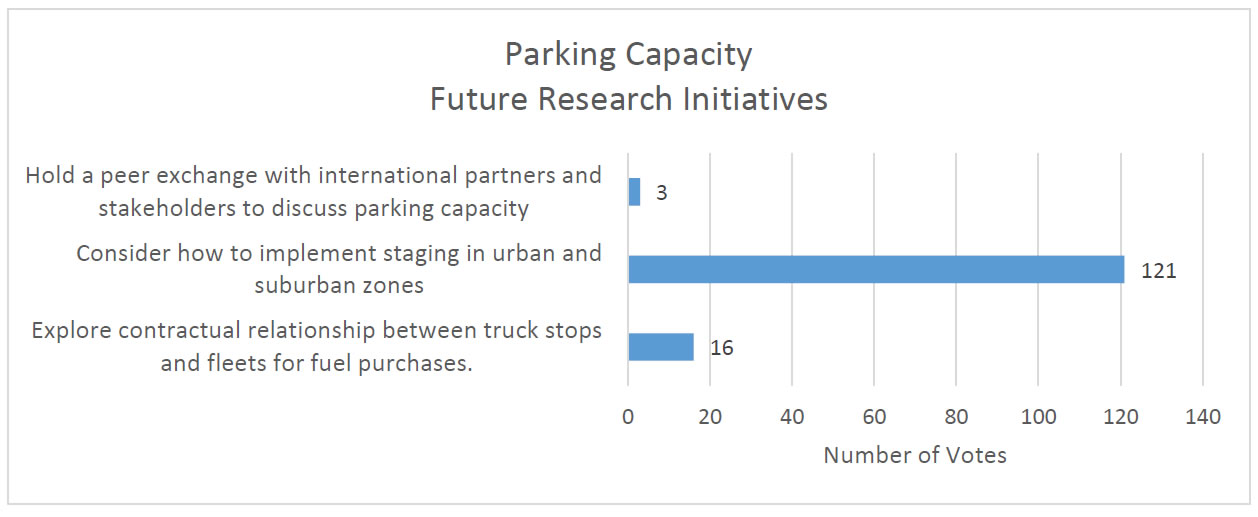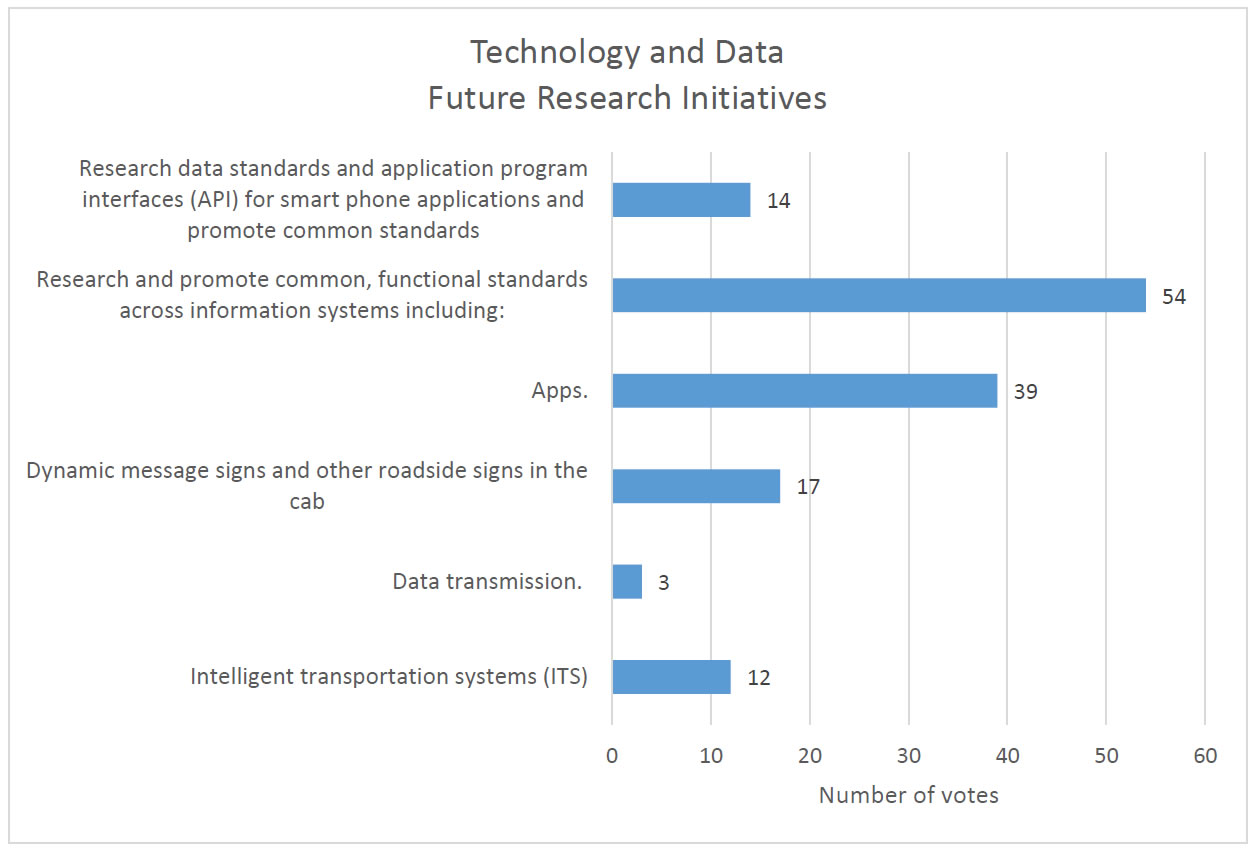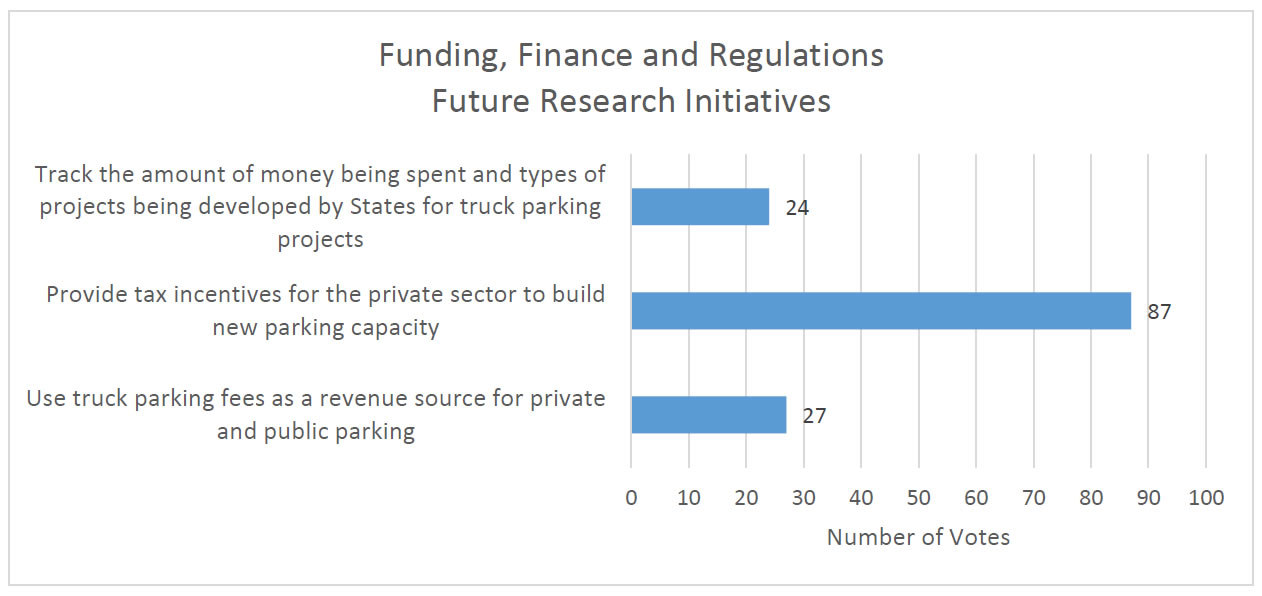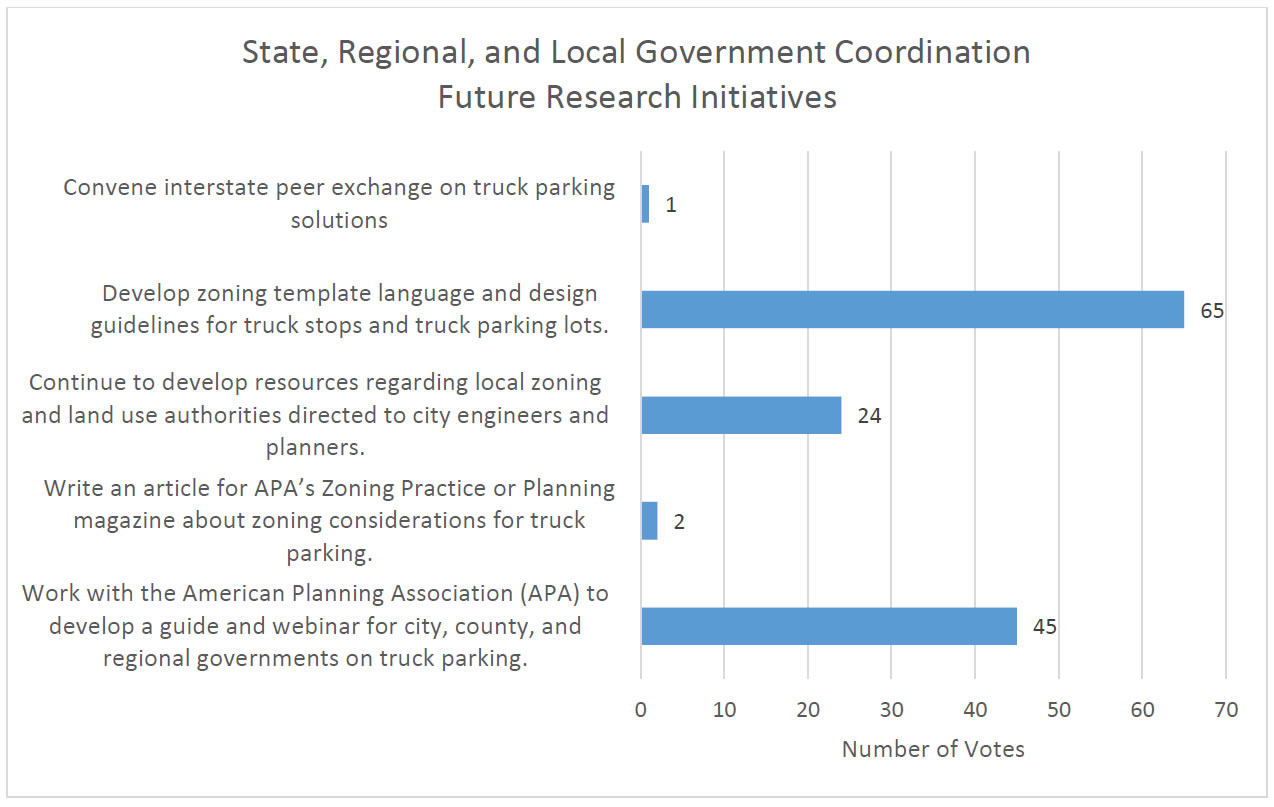National Coalition on Truck Parking: Web Conference - December 6, 2018
Printable Version [PDF 814 KB]
You may need the Adobe® Reader® to view the PDFs on this page.
Contact Information: Freight Feedback at FreightFeedback@dot.gov

U.S. Department of Transportation
Federal Highway Administration
Office of Operations
1200 New Jersey Avenue, SE
Washington, DC 20590

December 6, 2018
A recording of this meeting is available upon request.
Presenters:
- Scott Grenerth, Truck Specialized Trucking Services (TSPS)
- Caitlin Hughes, Federal Highway Administration (FHWA)
- Brian Hunter, Florida Department of Transportation (FDOT)
- Tiffany Julien, FHWA
- Martin Knopp, FHWA
- Jeff Loftus, Federal Motor Carrier Safety Administration (FMCSA)
- Jeff Purdy, FHWA
- Daniel Studdard, Atlanta Regional Commission (ARC)
- Marie Tucker, FDOT
- Jordan Wainer, USDOT Volpe Center
- Tiffany Wlazlowski-Neuman, National Association of Truck Stop Operators (NATSO)
Participants:
- There was a maximum of 170 participants in the web room.
Welcome and Introduction
Jordan Wainer, US DOT Volpe Center, welcomed attendees to the webinar and introduced Martin Knopp, FHWA Associate Administrator for Operations, for welcoming remarks.
Martin welcomed everyone to the meeting, thanked all for joining, and noted that safety is a top priority for the USDOT. The FHWA strategic plan supports this priority by working to reduce transportation related fatalities and injuries across the national transportation system. He summarized key safety initiatives the USDOT is leading to improve truck parking. These initiatives include improving safe parking conditions for truck drivers, incentivizing the use of innovative technology such as automated systems and truck platooning, and working to eliminate human trafficking.
Martin discussed how the shortage of truck parking has become a national safety concern. As truck traffic continues to rise as the demand for freight grows, there is a need for more truck parking. Lack of truck parking forces truck drivers to park in unsafe places such as on shoulders of highways or in vacant lots. The Jason's Law Survey, conducted in 2014, provided key findings in truck parking safety, which led to the creation of the National Coalition of Truck Parking (NCTP). The NCTP has four working groups that focus on Parking Capacity, Technology and Data, Funding and Finance, and State, Regional, and Local Government Coordination. Martin emphasized how collaboration among private and public stakeholders is key to improving the national network of safe truck parking.
Overview of Agenda
Caitlin Hughes, Director of the FHWA Office of Freight Management and Operations, provided an overview of the agenda for the meeting:
- Welcome and Introduction
- Background on the NCTP
- Update on Second Jason's Law Survey, 2018-2019
- NCTP Working Group Products Discussion
- Parking Capacity
- Technology and Data
- Funding, Finance and Regulations
- State, Regional, Local Government Coordination
- Future Research Priorities
- Federal Motor Carrier Safety Administration (FMCSA) Update on SmartPark Deployment
- Florida DOT Presentation
- Atlanta Regional Commission Presentation
- Core Partners Updates
- Next Steps for the NCTP
NCTP Working Group Background
Tiffany Julien, FHWA, provided an overview of the NCTP working groups. The working groups convened stakeholders from both public and private agencies to share best practices and develop products on truck parking issues. Each working group consisted of 40 to 60 people and was led by a champion to facilitate meetings and provide final input on products. Each working group met four times between November 2017 and August 2018 via webinar.
Update on Jason's Law
Jeff Purdy, FHWA, provided an update to the second Jason's Law Survey that was launched in November 2018. The Jason's Law Survey is part of FHWA's commitment to advancing truck parking, as mandated by MAP-21 section 1401(c)(3). Upon completion of the survey and analysis of the data, FHWA will publish an updated Jason's Law Survey and Comparative Assessment. The survey will:
- Update the inventory of truck parking and identify improvements to truck parking availability.
- Evaluate truck travel by State to assess increases or other changes in truck parking demand.
- Evaluate technology types to monitor availability and demand and assess recent advances in truck parking information systems and applications.
- Compile truck parking plans, studies, and projects completed by States and metropolitan planning organizations (MPOs).
Working Groups Products Discussion
Tiffany Julien introduced the working groups and thanked the following champions for their work in leading the groups:
- Brian Hunter, FDOT, Parking Capacity
- Dan Murray, American Transportation Research Institute (ATRI), Technology and Data
- Tiffany Wlazlowski-Neuman, NATSO, Funding, Finance and Regulations
- Scott Grenerth, TSPS, State, Regional, and Local Government Coordination
Parking Capacity Working Group
Brian Hunter, FDOT, presented on the products developed by the Parking Capacity Working Group. This working group consisted of members representing diverse organizations from both the private and public truck parking industry.
The purpose of the working group is to develop innovative and low-cost methods to increase the supply of short-term and overnight truck parking. Brian provided an overview of the following three products created by the working group:
- Creative Use of Right-of-Way (ROW) and Adjacent Areas.
- The product highlighted examples of successful, low-cost solutions for creating more truck parking by using existing facilities in the ROW or adjacent to the ROW. It included case studies from across the country, divided into categories of facility types including rest area conversions, parking at weigh stations, and parking at tourism centers, among others. Brian discussed one of these examples by explaining how the Missouri Department of Transportation (MoDOT) converted ten rest areas into truck parking facilities.
- Involvement of Shippers/Receivers to Address Truck Parking Capacity.
- This product included examples of ways that private companies can incorporate truck parking at their shipping/receiving facilities. It notes that truck parking and staging should be considered at every stage of the supply chain and incorporated at facilities that serve as origins or destinations for trucks. Brian discussed one of these examples by explaining how Meijer Grocery Stores designates a "Bullpen" area for trucks to park before their deliveries.
- Considerations for Maintaining Low-Cost Truck Parking Facilities.
- This product includes options that truck parking operators can choose to minimize implement at low-cost truck parking facilities. Brian discussed one of the options on safety and security. Organizations should consider emergency phones, fire extinguishers, access to a defibrillator, fencing and/or other barriers, security cameras, and lighting. These options might not be low-cost, but should be considered to ensure the facility is safe.
Technology and Data Working Group
Jordan Wainer presented on the products developed by the Technology and Data working group on behalf of Dan Murray, as he was unable to attend the meeting. The purpose of the Technology and Data working group is to develop innovative ideas for increasing the supply of truck parking by utilizing existing technology and data. Jordan provided an overview of the following three products created by the working group:
- Truck Parking App Survey Results.
- On behalf of the Technology and Data Working Group, ATRI conducted a survey on truck driver app preferences at the Mid America Trucking Show in Louisville, Kentucky in March 2018. The questions focused on the most important truck parking app feature, tools used to find available truck parking, what drivers like most and least about truck parking apps, and features drivers would like to see that many apps do not have. Jordan noted that drivers rated "Mapping features" and "driver-input into spot availability" as the most important app features.
- Best Practices for Truck Parking Availability Detection and Information Dissemination.
- This product included examples of different kinds of technology used for truck parking availability systems in different States throughout the country. Jordan discussed Michigan DOT's process for installing its Truck Parking Information System (TPIS) at 15 public and private truck parking locations on I-94.
- Technology and Data Research Needs Webinar.
- The Working Group held a webinar to review and discuss State-level truck parking studies, activities, and needs in August 2018. The webinar provided an update on the National Coalition on Truck Parking's activities, discussed high-level stakeholder needs, and provided examples from Florida and Colorado on recent truck parking research initiatives.
Funding, Finance, Regulations Working Group
Tiffany Wlazlowski-Neuman, NATSO, presented on the products developed by the Funding, Finance, Regulations Working Group. The purpose of this working group is to identify innovative ways to fund truck parking that can be an alternative to or leverage, limited Federal-aid funding and investigate regulatory flexibilities for truck parking funding.
Tiffany provided an overview of the following two products created by the working group:
- Public-Private Partnerships (P3) Examples and Considerations.
- This product includes examples of P3s and considerations for ways to create non-traditional funding agreements for additional truck parking. Tiffany discussed how Wyoming DOT used a Truck Parking Facilities (TPF) Program grant to construct 43 parking spaces off I-80 in Wamsutter, Wyoming.
- Emissions Reduction Grant Programs Fact Sheet.
- This product has general information on funding opportunities for the Congestion Mitigation and Air Quality (CMAQ) and Diesel Emissions Reduction Act (DERA) programs and project Examples of Idle Reduction Technologies (IRT) and Truck Stop Electrification (TSE). Tiffany discussed the successful truck stop electrification projects funded by emissions reductions programs. Through the DERA program, the Metropolitan Energy Center in Missouri received funding to replace 21 diesel long haul and work trucks with compressed natural gas trucks, and install 41 electrified parking spaces at two locations.
State, Regional, Local Government Coordination Working Group
Scott Grenerth, TSPS, presented on the products developed by the State, Regional, Local Government Coordination Working Group. The purpose of the working group is to identify innovative ways to influence State, regional and local governments to increase the supply of truck parking through zoning, public participation, and inclusion in planning documents.
Scott provided an overview of the following five products created by the working group.
- Examples of Truck Parking in State and MPO Freight Plans.
- This product highlights the following States and MPOs as notable examples for including truck parking in their freight plans: the Boston Region MPO and Massachusetts Department of Transportation (MassDOT), the Memphis MPO, the Atlanta Regional Commission (ARC), the Arizona DOT and Maricopa Association of Governments (MAG), and North Central Texas Council of Governments (NCTCOG). Scott discussed how the NCTCOG conducted a freight inventory in 2013 that identified a need for increased truck parking facilities and a greater understanding of truck parking networks within the region.
- How to Improve Truck Parking in Your Region Brochure.
- This product serves as a guide for the trucking industry on how to work with a MPO to improve truck parking. It includes information on what an MPO is, the MPO freight committee, how to get involved, and the importance of getting involved in truck parking decision-making. It also includes online resources that provide more information.
- The Importance of Considering Truck Parking in Local Zoning Codes Brochure.
- This product is geared towards local government planners to help ensure they consider truck parking in community plans and local zoning and development codes. It includes why truck parking is important, why local communities should make it a priority, background on Jason's Law, and, example resources.
- Local Zoning: Parking and Staging Requirements.
- This product includes several examples of local governments including provisions for truck parking and staging in their land use planning and zoning ordinances. These local plans and development regulations address staging, long-term parking, deliveries, and long-term parking for owner/operators near home. Scott discussed how Carson, California designated specific areas of the city in their zoning code where trucks can park for up to 72 hours and where trucks can load/unload.
- Talking Freight Webinar: "Best Practices in Industry and Government Coordination for Developing Truck Parking Solutions."
- This webinar was conducted as part of FHWA's Talking Freight webinar series in May 2018. The webinar discussed various truck parking coordination efforts taking place among trucking and truck parking industry stakeholders and State, regional, and local government representatives to identify and develop truck parking solutions. It included presenters representing the Arizona DOT, Boston MPO, and Memphis MPO.
Future Research Priorities
Caitlin Hughes provided an overview of the future research priorities that FHWA solicited from the working groups and core partners. She then asked the audience to vote for the most important priorities through a live poll. The following charts indicate the number of votes for each of the future priorities in each working group.




Other Future Research Ideas
Caitlin asked the audience to provide any other additional ideas not included in the polls. Other suggestions from the group included:
- Examine the role of idling minimization (via providing offboard technology, or giving priority to trucks with onboard technology) as way to improve abutter acceptance of new facilities in populated areas, or to aid in finding synergies between states' freight plans and greenhouse gas reduction goals, or to harness CMAQ funds.
- Work with the private sector to use Truck GPS data to identify truck parking location and duration information to supplement the Jason's Law survey.
- Explore other surface materials (besides concrete) for truck parking lots.
- Develop guidance for new warehousing and industrial facilities to ensure there is sufficient on-site or adjacent truck parking, similar to the Meijer Grocery Store distribution center example.
- Run some sort of public campaign on the importance of truck parking and the service that truck drivers provide to the public by moving their goods.
- Investigate utilizing (a) stadiums and sports venues; (b) large shopping malls overnight; and, (c) county and regional racetracks for truck parking.
- Consider capacity for secure truck parking, particularly for high-value loads that cannot be parked in most public lots or many private facilities.
- Prepare for Autonomous and Platooning Freight Vehicles - What are the impacts on truck parking?
- Consider sufficient capacity for oversized vehicles and overweight vehicles.
FMSCA Update on Accelerating SmartPark Deployment
Jeff Loftus, Technology Division Chief for the FMCSA, provided an update on accelerating SmartPark deployment. SmartPark is a nickname for truck parking information systems using Intelligent Transportation Systems (ITS) to provide truck parking availability information. Jeff discussed the background and overview of the study, categories of recommendations and emerging themes.
Since 2005, FMCSA recognized SmartPark as crucial to monitoring availability of truck parking and providing real-time information on available parking to truckers to help reduce driver fatigue. This study was undertaken to develop strategies for accelerating SmartPark systems deployment.
The study focuses on the following four tasks:
- Survey and assessment of ITS technology
- Market analysis (focus on cost and finance issues)
- Research on opportunities and barriers
- Strategic plan for accelerating SmartPark deployment
In addition, the study will provide strategic recommendations related to technology, financial, acceptance and institutional categories for accelerating SmartPark deployment.
Jeff ended his presentation by discussing emerging themes identified in the study so far. These themes mirror issues mentioned by the working groups and include data standards, modular system design, operational cost-benefit and ROI data, notification of available federal funding, publicized success and engaging the private sector.
Florida DOT Presentation
Marie Tucker of Florida DOT (FDOT), project manager for statewide truck parking availability system, provided an overview of the work being conducted by FDOT to provide more truck parking across the State.
FDOT initiated a project in 2011 in partnership with Florida International University to study the availability of truck parking statewide and to understand which areas were being used more intensively for parking than others. It determined that FDOT truck parking sites had higher saturation by parked trucks in the urban areas than the rural areas and weigh stations. From that study, FDOT knew it wanted to better balance the use of its truck parking, so it decided to initiate an effort to show truck drivers real-time availability of FDOT truck parking throughout the State. In order to do that, FDOT concluded that it needed to test various technologies that are available to track truck parking availability. Starting in 2016, FDOT worked with the University of Florida to carry out a study on the accuracy of in-ground sensors to measure and track truck parking availability and how the technology would pair with the State's existing advanced traffic management system (ATMS) technology. FDOT used an existing rest area as a test site for the in-ground measurement technology. FDOT cross-referenced the results of the tested technology with the results of video cameras that counted the number of available parking spaces. FDOT is conducting this study in three phases, and it is currently in the first phase of the study, which is to deploy the test technology statewide. In phase two, the data will be collected and stored to provide predictive analysis. Finally, phase three will deploy the technology in private truck stops.
The State of Florida is also creating a statewide freight network. All of the Florida weigh stations will be connected on fiber, which all of the State's intelligent transportation systems (ITS) also use. This will allow the State to perform mainline screening to help move freight faster, reduce traffic, and help reduce the need for truck parking. The State will also use software to learn more about truck driver behavior, such as why drivers are stopping, where, and for how long.
Marie provided the participants the link to the project website, www.floridatruckinginfo.com.
Atlanta Regional Commission Presentation
Daniel Studdard of the ARC, the MPO for the Atlanta region, began a study in 2018 to help demonstrate the benefit of truck parking to the private sector. The study builds on a freight plan developed in 2015 and responds in part to local complaints of trucks parking in illegal areas.
ARC acknowledges that insufficient truck parking causes drivers to drive for longer periods of time, which contributes to congestion and reduces air quality. Being able to point this out and demonstrate how it impacts everyone in the region is helpful in making the case for community support for increased truck parking supply. There are restrictions to truck parking in local zoning in the Atlanta area, which presents challenges providing additional truck parking. ARC has found that when it presents to the public about the need for additional truck parking, the public can often quickly understand the benefits of providing truck parking.
In order to better understand where to focus its efforts for additional truck parking, the ARC would like to have better data on truck location. The ARC worked with ATRI to gather available data, but there are some limitations to the dataset. ARC is investigating using truck parking sensors to better understand how trucks are using existing parking facilities.
The ARC acknowledges that it, as an MPO, cannot implement solutions, so it has to transfer the responsibility for creating more truck parking to local governments. The next steps for ARC include working with Gwinnett County to conduct a truck parking study, to assist in creating four regional truck parking plans, and encourage modifying zoning codes to make it possible to provide more truck parking.
Update from Core Partners
Jordan invited the NCTP Core Partners to provide updates. Core partners include the American Association of State Highway Transportation Officials (AASHTO), the American Trucking Associations (ATA), ATRI, the Commercial Vehicle Safety Alliance (CVSA), NATSO, and the FHWA Resource Center Freight Team.
Tiffany Wlazlowski-Neuman (NATSO) announced that NATSO has launched the Park My Truck smartphone app. She stated that State DOTs might be interested in this app and can list their truck parking areas on the app.
Lisa Randall, the technical director for the FHWA Resource Center's Transportation Program Management, Asset Management, and Freight group, notified NCTP members of her group's newly offered truck parking technical roundtable. The roundtable is a forum that brings together public and private truck parking stakeholders for a specific region and helps that group identify priorities and carry out implementation leading to additional truck parking. If States or MPOs are interested in holding a roundtable, they can reach out to their freight contact at their FHWA Division Office.
Desiree Wood of Real Women in Trucking provided feedback to Daniel Studdard (ARC) on the availability of truck parking and efforts to provide more. She offered the members of her organization as potential participants in any research studies seeking driver input related to truck parking.
Susan Howard from AASHTO shared information on the Special Committee on Freight that AASHTO recently created. The committee's focus is to advance truck parking, which is included in AASHTO's work plan for this year. AASHTO is looking for ways to coordinate with AMPO directly on this effort.
Jordan thanked the core partners for providing updates and then proceeded to the Q&A session.
Q&A
Jordan read questions from the chat pod and posed them to webinar attendees.
What are the impacts of autonomous vehicles and truck platooning on truck parking?
Jeff Purdy responded that the changes will be long-term. Jeff Loftus responded that automated trucking and truck platooning will begin to roll out in 2019, but it will be just a handful of trucks and routes out of several million. It will likely be decades before these changes have a significant impact on truck parking.
Do you feel that your efforts and others will result in additional truck parking, or is local indifference, resistance, and the public process is a major barrier?
Change will need to occur at the local level and that although change is not occurring as quickly as many would like, progress is being made.
How does the ARC identified space utilization?
Daniel responded that his group used a wiki-mapping program to discuss truck parking. The ARC gave planners who were providing feedback on the ARC's truck parking efforts the opportunity to put a pin on a GIS-enabled map to identify where drivers were parking.
Next Steps for NCTP and Conclusion
Attendees should continue to develop their local partnerships and invite partner groups to participate in truck parking efforts, including the NCTP, in the future.
Tiffany and Jeff thanked the group members for their participation and expressed hope for the impacts that this group will have. Caitlin thanked the participants as well. She mentioned that people can reach out to Tiffany or Jeff if they are not currently a member of the working group but would like to be.
Jordan then concluded the webinar.